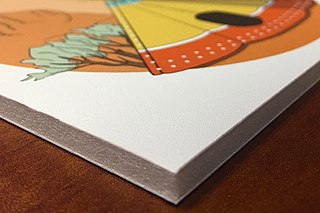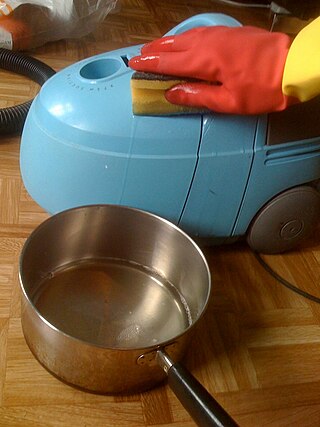
Adhesive remover is a substance intended to break down and remove glue and its remnants from surfaces.

Adhesive remover is a substance intended to break down and remove glue and its remnants from surfaces.
Adhesive removers are intended to break down glue so that it can be removed from surfaces easily. [1] [2] [3] Formulations may be designed to remove a broad range of adhesives or to address a specific bond. [1] Many general purpose removers are intended to remove residue from adhesive tape. [1] [2] [3]
Adhesive removers are often based on organic solvents, which can dissolve or soften many adhesive polymers that do not dissolve in water. They may also contain a gelling agent, increasing viscosity so that the product sticks to the area to be treated rather than running off. Common solvents used include D-limonene, aliphatic alkanes, and acetone.
Heptane is also used as an adhesive remover by stamp collectors. Since 1974, the United States Postal Service has issued self-adhesive stamps that some collectors find difficult to separate from envelopes via the traditional method of soaking in water. Heptane-based products, like Bestine, as well as limonene-based products, have become popular solvents for removing stamps more easily. [4]

Adhesive, also known as glue, cement, mucilage, or paste, is any non-metallic substance applied to one or both surfaces of two separate items that binds them together and resists their separation.

Cyanoacrylates are a family of strong fast-acting adhesives with industrial, medical, and household uses. They are derived from ethyl cyanoacrylate and related esters. The cyanoacrylate group in the monomer rapidly polymerizes in the presence of water to form long, strong chains.

A solvent is a substance that dissolves a solute, resulting in a solution. A solvent is usually a liquid but can also be a solid, a gas, or a supercritical fluid. Water is a solvent for polar molecules, and the most common solvent used by living things; all the ions and proteins in a cell are dissolved in water within the cell.

Heptane or n-heptane is the straight-chain alkane with the chemical formula H3C(CH2)5CH3 or C7H16. When used as a test fuel component in anti-knock test engines, a 100% heptane fuel is the zero point of the octane rating scale (the 100 point is 100% iso-octane). Octane number equates to the anti-knock qualities of a comparison mixture of heptane and iso-octane which is expressed as the percentage of iso-octane in heptane, and is listed on pumps for gasoline (petrol) dispensed globally.
In philately, gum is the substance applied to the back of a stamp to enable it to adhere to a letter or other mailed item. The term is generic, and applies both to traditional types such as gum arabic and to synthetic modern formulations. Gum is a matter of high importance in philately.

A self-adhesive stamp is a postage stamp with a pressure-sensitive adhesive that does not require moistening in order to adhere to paper. They are usually issued on a removable backing paper.

Paint stripper or paint remover is a chemical product designed to remove paint, finishes, and coatings, while also cleaning the underlying surface. Chemical paint removers are advantageous because they act on any kind of geometry and they are cheap. They can however be slow acting.

Rubber cement is an adhesive made from elastic polymers mixed in a solvent such as acetone, hexane, heptane or toluene to keep it fluid enough to be used. This makes it part of the class of drying adhesives: as the solvents quickly evaporate, the rubber solidifies, forming a strong yet flexible bond.

Limonene is a colorless liquid aliphatic hydrocarbon classified as a cyclic monoterpene, and is the major component in the essential oil of citrus fruit peels. The (+)-isomer, occurring more commonly in nature as the fragrance of oranges, is a flavoring agent in food manufacturing. It is also used in chemical synthesis as a precursor to carvone and as a renewables-based solvent in cleaning products. The less common (-)-isomer has a piny, turpentine-like odor, and is found in the edible parts of such plants as caraway, dill, and bergamot orange plants.

Foamcore, foam board, or paper-faced foam board is a lightweight and easily cut material used for mounting of photographic prints, as backing for picture framing, for making scale models, and in painting. It consists of a board of polystyrene foam clad with an outer facing of paper on either side, typically white clay-coated paper or brown kraft paper.

A primer or undercoat is a preparatory coating put on materials before painting. Priming ensures better adhesion of paint to the surface, increases paint durability, and provides additional protection for the material being painted.

Animal glue is an adhesive that is created by prolonged boiling of animal connective tissue in a process called rendering. In addition to being used as an adhesive, it is used for coating and sizing, in decorative composition ornaments, and as a clarifying agent.
Wood glue is an adhesive used to tightly bond pieces of wood together. Many substances have been used as glues. Traditionally animal proteins like casein from milk or collagen from animal hides and bones were boiled down to make early glues. They worked by solidifying as they dried. Later, glues were made from plant starches like flour or potato starch. When combined with water and heated, the starch gelatinizes and forms a sticky paste as it dries. Plant-based glues were common for books and paper products, though they can break down more easily over time compared to animal-based glues. Examples of modern wood glues include polyvinyl acetate (PVA) and epoxy resins. Some resins used in producing composite wood products may contain formaldehyde. As of 2021, “the wood panel industry uses almost 95% of synthetic petroleum-derived thermosetting adhesives, mainly based on urea, phenol, and melamine, among others”.

Pressure-sensitive adhesive is a type of nonreactive adhesive which forms a bond when pressure is applied to bond the adhesive with a surface. No solvent, water, or heat is needed to activate the adhesive. It is used in pressure-sensitive tapes, labels, glue dots, stickers, sticky note pads, automobile trim, and a wide variety of other products.

Cleaning agents or hard-surface cleaners are substances used to remove dirt, including dust, stains, foul odors, and clutter on surfaces. Purposes of cleaning agents include health, beauty, removing offensive odors, and avoiding the spread of dirt and contaminants to oneself and others. Some cleaning agents can kill bacteria and clean at the same time. Others, called degreasers, contain organic solvents to help dissolve oils and fats.
Stain removal is the process of removing a mark or spot left by one substance on a specific surface like a fabric. A solvent or detergent is generally used to conduct stain removal and many of these are available over the counter.

Conservation and restoration of ceramic objects is a process dedicated to the preservation and protection of objects of historical and personal value made from ceramic. Typically, this activity of conservation-restoration is undertaken by a conservator-restorer, especially when dealing with an object of cultural heritage. Ceramics are created from a production of coatings of inorganic, nonmetallic materials using heating and cooling to create a glaze. These coatings are often permanent and sustainable for utilitarian and decorative purposes. The cleaning, handling, storage, and in general treatment of ceramics is consistent with that of glass because they are made of similar oxygen-rich components, such as silicates. In conservation ceramics are broken down into three groups: unfired clay, earthenware or terracotta, and stoneware and porcelain.

Pressure-sensitive tape or pressure-sensitive adhesive tape is an adhesive tape that sticks when pressure is applied without the need for a solvent or heat for activation. It is also known in various countries as self-stick tape, sticky tape, or just adhesive tape and tape, as well as genericized trademarks, such as Sellotape, Durex (tape), Scotch tape, etc.
Adhesive bonding is a joining technique used in the manufacture and repair of a wide range of products. Along with welding and soldering, adhesive bonding is one of the basic joining processes. In this technique, components are bonded together using adhesives. The broad range of types of adhesives available allows numerous materials to be bonded together in products as diverse as vehicles, mobile phones, personal care products, buildings, computers and medical devices.